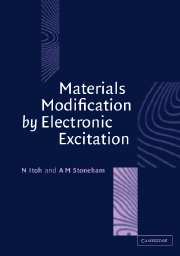Book contents
- Frontmatter
- Contents
- Preface
- 1 Concepts: Excitation, polarons and electronic structure
- 2 Energy deposition and redistribution in solids
- 3 Electron–lattice coupling and its consequences
- 4 Self-trapping
- 5 Local lattice modification by electronic excitation of halides
- 6 Local lattice modification by electronic excitation of crystalline insulating oxides
- 7 Local lattice modification of semiconductors by electronic excitation
- 8 Local lattice modification of amorphous materials by electronic excitation
- 9 Atomic emission and surface modification
- 10 Interface reactions induced by electronic excitation
- 11 High excitation intensities
- 12 Applications of materials modification by excitation
- References
- Index
12 - Applications of materials modification by excitation
Published online by Cambridge University Press: 11 August 2009
- Frontmatter
- Contents
- Preface
- 1 Concepts: Excitation, polarons and electronic structure
- 2 Energy deposition and redistribution in solids
- 3 Electron–lattice coupling and its consequences
- 4 Self-trapping
- 5 Local lattice modification by electronic excitation of halides
- 6 Local lattice modification by electronic excitation of crystalline insulating oxides
- 7 Local lattice modification of semiconductors by electronic excitation
- 8 Local lattice modification of amorphous materials by electronic excitation
- 9 Atomic emission and surface modification
- 10 Interface reactions induced by electronic excitation
- 11 High excitation intensities
- 12 Applications of materials modification by excitation
- References
- Index
Summary
Aims of materials modification
Most of our book aims at a coherent and (where possible) quantitative understanding of materials modification following electronic excitation. Yet this understanding is only one part of the picture. Another major component is practical: how can the consequences of this controllable excitation be exploited? We may categorise most areas of major practical importance under a small number of headings:
Removal of surface material, especially in a controlled way;
Modification of the surface layers;
Modification of the bulk in a selected way;
Altering the absolute rate of a bulk or surface process;
Switching from one process to another: altering branching ratios. In this category, we might also include the manipulation of excitation through materials design, even though the material itself is not modified by this excitation. For example, the xerographic process relies on the manipulation of electron and hole excitations in Se. The photochemical splitting of water using colloidal particles (typically TiO2/RuO2 with Pt) (e.g. Grätzel 1981) relies on the appropriate use of the energy stored following optical excitation, which ideally leaves the particle itself unaltered.
Creation and control of damage
Damage may be intentional or unintentional. Damage avoidance is achieved by the minimisation of those processes by which excitation causes harmful modifications, or simply by arranging for the damage to occur only in unimportant regions.
- Type
- Chapter
- Information
- Materials Modification by Electronic Excitation , pp. 444 - 466Publisher: Cambridge University PressPrint publication year: 2000



